
This facility provides for the capture of a manually initiated accounting activity.
A manually initiated accounting activity is effectively an online journal entry or payment requisition (cheque or EFT).
Accounting activities are set up with accounting rules that define what accounts are debited and credited. When they are set up, an indicator is set that defines whether or not the accounting activity can be captured online (i.e. manually initiated). If it is not set, it means that the accounting activity can only be created by a system process.
The accounting activity also has an indicator that defines whether or not the accounting activity generates a money movement (i.e. a payment by cheque or EFT). If one of these accounting activities is captured online, it is a payment requisition.
All accounting activities are associated with a process and some will be associated with the process MANUAL INITIATE, which means that they will only be created via online capture.
As all accounting activities have predefined accounting rules, you can only select an accounting activity and not the accounts to be debited and credited. This provides a strict control to ensure that the correct accounting transactions are generated.
All manually initiated accounting activities require authorization. Authorization (or rejection) of manually initiated accounting activity journals is done by users with the necessary authority. Authorized journals create business transaction occurrences, together with money movement instructions (cheque or EFT) when applicable.
Note:
The doer and authorizer may not be the same person.
If a user is not authorised to perform a function, an error message will be displayed.
Log in to the system from the Logon page.
Click ACCOUNTING.
The Welcome screen will be displayed.

From the main menu on top, select Transaction Capture. A sub-menu will be displayed on the left.

Select Manual Accounting Transactions
The JU2BK Manual Accounting Journal screen will be displayed.

Select Create Accounting Journal from the menu on the left.

The JU2BK Accounting Journal Details screen will be displayed.

Descriptions of the input fields on this screen appear below.
|
Scheme / Member Identifiers |
|
|
|
Accounting Activity |
The code and process associated to the selected accounting activity. Click the LIST button at the end of the line. This links to the JU2AF Accounting Activity List screen and displays a list of accounting activities with a process of MANUAL INITIATE for which, in addition to the other criteria currently used, the discontinued date is null or greater than the current date and the manual initiate indicator is Y. Note: SEARCH is disabled on the JU2AF Accounting Activity List screen.
Note: The discontinued date will not be displayed on the JU2AF Accounting Activity List screen.
Once a selection has been made, click SELECT. |
|
|
Scheme Code
|
The code and name of the selected product. This is the name by which the product is registered with the Financial Services Board. Click the LIST button at the end of the line. This links to the JU1BK List screen and displays a list of products to select from. Once a selection has been made, click SELECT. |
|
|
Global Type |
The code and description of the selected global type. Click the LIST button at the end of the line. This links to the Scheme Global Type List screen and displays a list of income types to select from. Once a selection has been made, click SELECT. If the selected income type is not active, a warning message will be displayed. Note: The system determines via the accounting rule for the accounting activity selected whether the income type is mandatory or optional. |
|
|
Portfolio |
The description of the selected portfolio. Click the LIST button at the end of the line. This links to the JU1BV Scheme Portfolio List screen and displays a list of investment mediums to select from. Once a selection has been made, click SELECT. If the selected portfolio is not active, a warning message will be displayed. Note: The system determines via the accounting rule for the accounting activity selected whether the portfolio is mandatory or optional. |
|
|
Pay Centre |
The code and description of the selected pay centre. A pay centre is the entity from which income is received for a group of members. The code will have been defined by the user at the time of setting up the pay centre. Click the LIST button at the end of the line. This links to the JU1DL Scheme Pay Centre List screen and displays a list of pay centres to select from. Once a selection has been made, click SELECT. Note: The system determines via the accounting rule for the accounting activity selected whether the pay centre is mandatory or optional. |
|
|
Membership Number |
The number identifies a person's membership of the product. Membership numbers are unique per product. Required if the transaction is for a specific member. Click the LIST button at the end of the line. This links to the JU3AO List of Members for a Scheme/Pay Centre screen and displays a list of members to select from. Once a selection has been made, click SELECT.
Note: If a selection is made for the Secondary Membership field (see below), the system will populate the Membership Number field with the Reference Number of the Membership to which the Secondary Membership is linked. |
|
|
Secondary Membership |
The number identifying an annuity beneficiary. Click the LIST button at the end of the line. This links to the JU4EU Annuity Beneficiaries screen and displays a list of all of the Natural Person records for which there is a Client Relationship with a Client Relationship Type of SPOUSE, DEPENDANT, DISABLED DEPENDNT or FIN DEPENDANT linked to a Membership that is linked to the Product selected. Once a selection has been made, click SELECT.
Note: When a Secondary Membership is selected, the system will populate the Membership Number field with the Reference Number of the Membership to which the Secondary Membership is linked.
For more information refer to Secondary Membership below. |
|
|
Finance Checklist |
Click the FINANCE CHECKLIST action button to display the Checklist.
Note: This action button will only be enabled when a Service Request for a Process of Finance is selected in My Work. For more information refer to My Work Process SR Finance
Supplements Tags Finance Checklist Income Checklist |
|
|
Bank Details |
|
|
|
Debit (To) Account |
For bank deposits – the account into which the money is deposited. For EFT payments – the account into which the money is to be transferred. Note: The system determines via the accounting rule for the accounting activity selected whether the debit account is mandatory or optional.
If no EFT Rule is found for the global type, the following error message will be displayed: EFT Rule for Global Type not found. |
|
|
Account Type |
The type of bank account. Valid bank account types are Current, Savings, Transmission. |
|
|
Sort Code |
If the bank account details are not supplied according to the bank account rule linked to the accounting activity, click the LIST button at the end of the line. This links to the JU1CC Product Bank Account List screen and displays a list of account holders to select from. Once a selection has been made, click SELECT. If the selected bank account is not active, a warning message will be displayed. Once selected, the account type and number will automatically populate the relevant fields above. |
|
|
Credit (From) Account |
For cheque payments and EFT’s – the account out of which the money is to be paid. For bank debits, e.g. bank charges, transaction reversals, etc. – the account to be credited.
Note: If no global type has been selected, the following error message will be displayed:
A Global Type must be selected.
Note: If the Credit Account in the Accounting Rule linked to the Accounting Activity selected is BANK, the Credit (From) Account under Bank Details will be enabled for selection from the list of Product Bank Accounts.
If the Bank Account selected is not the same as the Credit (From) Bank Account defined in the EFT Rule linked to the Accounting Activity and Product selected, the following warning message will be displayed:
The from bank account you have selected is not the same as the bank account in the bank account rule.
Click OK to remove the message. |
|
|
Account Type |
Unique identifier supplied by the bank. |
|
|
Sort Code
|
If the bank account details are not supplied according to the bank account rule linked to the accounting activity, click the LIST button at the end of the line. This links to the JU1CC Product Bank Account List screen and displays a list of account holders to select from. Once a selection has been made, click SELECT. If the selected bank account is not active, a warning message will be displayed. Once selected, the account type and number will automatically populate the relevant fields above. Note: If the TRANSFER MONEY indicator on the accounting activity is set to Y, the bank account selected in the EFT rule will be inserted and cannot be changed. If the EFT indicator on the accounting activity is set to Y, the LIST button remains disabled. |
|
|
Transaction Details |
|
|
|
Service Type |
The description of the service for which a transaction fee is charged. Click the LIST button at the end of the line. This links to the JU1CX Scheme Services List screen and displays a list of services to select from. Once a selection has been made, click SELECT. If the selected service type is not active, a warning message will be displayed. |
|
|
Currency |
Identifies the currency in which the business transaction (BT) must be created.
Click the LIST button at the end of the line. This links to the JU0AC Permitted Value List screen and displays a list of currencies to select from. Once a selection has been made, click SELECT. |
|
|
Event |
The benefit event to which the transaction refers (e.g. late retirement). Click the LIST button at the end of the line. This links to the BIAB Benefit Event List screen and displays a list of events to select from. Once a selection has been made, click SELECT. |
|
|
Monetary Amount |
The total of the business transaction. |
|
|
Due Date |
The date on which the transaction should have occurred. |
|
|
Unitize Value |
The unit amount of the business transaction, i.e. when the UNITIZE VALUE flag is set for one of the BT’s connected to the activity via the rules. To select this, click on the tick-box. This will enable the capture of a value in the field alongside it. |
|
|
Include in Investment / Disinvestment Advice |
Tick this box if the transaction must be included in an investment or disinvestment advice. Note: This selection will be displayed only if one of the accounts in the accounting rule associated to the selected accounting activity is INVESTTRANST or DISINVTRANST, and the stakeholder is FUND. |
|
|
Effective Date |
The date on which the financial implication of the transaction was expected or required to take effect. |
|
|
Transaction Date |
The date on which the business event occurred (e.g. date of deposit). |
|
|
Exchange Rate |
The specific deal exchange rate supplied by the foreign exchange department. Note: The specific deal exchange rate is requested from the foreign exchange department and must not be looked up on the exchange rate table. |
|
|
Forex Deal Number |
The deal number that was booked to obtain a rate of exchange. Note: If the payment is over GBP 25,000, a deal has to be booked two days in advance of the value date to receive the best rate of exchange. |
|
|
Swift Bank ID Code |
Society for Worldwide Interbank Financial Telecommunication Bank Identifier Code. |
|
|
Bank Interface |
A Bank Interface to enable the electronic transfer of funds between bank accounts. Select a value from the drop-down box. The drop down box displays a list of the different types of services available, i.e. Barclays Kenya, Barclays Zambia, Cashfocus, Nedinform, CPS, ACB, LDC, CPY, FNB Online, BIB, etc.
Note: When the BTs are extracted for the EFT, the system will read the Process and the Bank Interface fields defined for the Bank Account on the Account Details screen. If nothing has been defined, the system will read the Bank Interface on the JU1CC Product Bank Account Detail screen. |
|
|
Payment Details |
|
|
|
Payee Name |
The name of the person or organisation appearing on the cheque. This is mandatory if PAYMENT TYPE is selected. |
|
|
Payment Reference |
The Payment Reference that must appear on the recipient’s Bank Statement when payments are made via EFT. |
|
|
Payment Type |
Indicates the mode of payment out of the product account (e.g. cheque, EFT, group payment). Select from the drop-down list. If EFT is selected, the document number field will be cleared and disabled. |
|
|
Document Number |
A number referencing a source document that provides the base information for the business transaction. Note: This is not available if PAYMENT TYPE of EFT is selected, as this is then used to store the EFT number when the EFT is processed. The EFT number is automatically generated. |
|
|
Document Chained Number |
This field can contain a number referencing a source document that provides the base information for a previous business transaction to which this one is linked. This is a unique number that applies to all occurrences of one allocation in order to tie them all together. |
|
|
Userid |
The system user ID of the person who captured the manual accounting activity. If the Accounting Activity Journal has subsequently been edited, then the userid of the person making the change(s) will be stored. |
|
Capturing a Transaction on a Saturday
When SAVE is selected and one of the Accounts in the Accounting Rule linked to the Accounting Activity selected is INVESTMEMB or INVSTMEMUNIT, or if the Money Movement Indicator on the Accounting Activity is Y and the Payment Method is EFT, the existing Transaction Date validation will be applied, i.e. if the Status of the Date on the Calendar is WEEKEND or PUBLIC HOLIDAY, an error message will be displayed.
For all other Accounting Activities, the system will read the Status on the Calendar for the Date equal to the Transaction Date, and if it is WEEKEND, will check if the Date is a Saturday. If it is, the journal will be enabled to be saved.
Secondary Membership
When the LIST button is selected for the Secondary Membership field, the system will display the JU4EU Annuity Beneficiaries screen.

This screen displays a list of all of the Natural Person records for which there is a Client Relationship with a Client Relationship Type of SPOUSE, DEPENDANT, DISABLED DEPENDNT or FIN DEPENDANT linked to a Membership that is linked to the Product selected.
The Status field displays the following values:
- ANNUITANT
- SPOUSE
- DEPENDANT
- DISABLED DEPENDNT
- FIN DEPENDANT
When a Secondary Membership is selected, the system will populate the Membership Number field with the Reference Number of the Membership to which the Secondary Membership is linked.
If the Payment Method selected is EFT or BANK TRANSFER, the system will read the Client DTI Account record linked to the Person selected for the Secondary Membership and populate the values below with the details of the DTI Account found:
- Account Type (Bank Account Type)
- Account Number (DTI Account Number)
- Branch Code (DTI Branch Code)
When SAVE is selected, the Business Transaction will be created with the Ben Client Instance ID equal to the Instance ID of the Secondary Membership selected.
Notation
You can attach comments to the accounting activity journal. Click NOTE. The JV0AC Notation screen will be displayed.

Enter the relevant text details, then click OK.
For further information regarding the notes facility, refer to Notes under
Product Launch Requirements
Additional Menu Options
If the Money Movement Indicator on the Accounting Activity selected is Y and the Payment Method selected is EFT, the system will read the value for Description on the Global Parameter with a Parameter Type of EFT CUT-OFF.
If the current time is greater than the value found and the Transaction Date is equal to current date, the following message will be displayed:
It is after the cut-off time for EFT payments. The transaction date will be set to the next working day
When the OK button is selected on the message, the Pre-authorised Business Transaction will be created with the Transaction Date and Effective Date equal to the next working day.
If the next working day is a Saturday, the Transaction Date will be set to the next working day after the Saturday.
If the Transaction Date is less than the current date, the following error message will be displayed:
The transaction date must be equal to current date or greater than current date.
To cancel the creation of the accounting journal, click CANCEL. A confirmation message will be displayed:
All changes will be lost. Are you sure you want to cancel?

Click YES to confirm that the Accounting Activity Journal must be cancelled, or click NO or CANCEL to remain on the JU2BK Accounting Journal Details screen.
Once all the required information has been completed, click SAVE.
A confirmation message will be displayed:
Do you want to create this Accounting Activity Journal?

Click YES to confirm that the Accounting Activity Journal must be created, or click NO or CANCEL to cancel the creation and remain on the JU2BK Accounting Journal Details screen.
The JU2BK Manual Accounting Journal screen will be displayed with the newly created accounting journal.

This is now available for authorisation.
Forex Deal Number and Bank Details
When SAVE is selected, the system will validate that the Forex Deal Number and the Bank details (if these fields have values) are already on the JU2ER Exchange Rate Deals List. If they are not found, an error message will be displayed.
Selected Deal Number / Bank does not exist on Deal Exchange Rate table.

Click OK to remove the message.
Create the Forex Deal Number and Exchange Rate on the JU2ER Exchange Rate Deals List screen.
For more information on exchange rates deals, refer to Parameters under
Product Launch Requirements
Additional Menu Options
Note:
If the account in the accounting rule for the accounting activity is INVESTTRANST or DISINVTRANST, and the INCLUDE IN INVESTMENT / DISINVESTMENT ADVICE box has not been ticked, the following confirmation message will be displayed:
The Include in Investment / Disinvestment Advice check box is not ticked do you want to continue?

Click YES to confirm that you wish to continue, or click NO or CANCEL to remain on the JU2BK Accounting Journal Details screen.
If YES is selected, then the following confirmation message will be displayed:
Do you want to create this Accounting Activity Journal?

The JU2BK Manual Accounting Journal screen will be displayed with the accounting journal that was created.
This is now available for authorisation.
To authorise and / or edit an accounting journal, select the required journal from the JU2BK Accounting Journal screen, and select Authorise/Edit Accounting Journal from the sub-menu on the left.

The JU2BK Accounting Journal Details screen will be displayed. Refer to Create an accounting activity journal above.
To cancel the information captured by the doer, click REJECT. The following CONFIRMATION box will be displayed:

Click YES to reject the transaction.
The transaction will be removed from the JU2BK Manual Accounting Journal screen.
To save the entered information and create the business transactions, click AUTHORISE.
Note:
A different authoriser is required to authorise the journal. The following message will be displayed:
Error. Authoriser cannot be the same as doer.

Click OK to remove the message.
The following CONFIRMATION box will be displayed:

Click YES.
Authorisation Notes:
When AUTHORISE is selected, if the value for Currency is not equal to the Currency for the Product and there is no value for Forex Deal Number or Exchange Rate, the system will read the Exchange Rate table and find the Exchange Rate for the Currency and with an Effective Date equal to current date.
If an Exchange Rate with an Effective Date equal to current date is not found, the following error message will be displayed:
No foreign exchange rate found for the currency selected for current date.
The system will read the value for Foreign Payment Cut-off Time on the Credit (From) Bank Account and if the current time is greater than the value found, the following error message will be displayed:
It is after the cut-off time for foreign currency payments, please authorise this transaction on the next working day.
Note: The validation for the Deal Number and Deal Exchange Rate is currently done when SAVE is selected.
Note:
When the Accounting Journal is authorised, the system will check the From (Credit) Bank Account to the From (Credit) Bank Account defined in the EFT Rule for the Accounting Activity and Product selected in the Journal. If the bank account is not the same, the following warning message will be displayed:
The from bank account selected is not the same as the bank account in the bank account rule. Do you wish to continue?

Click YES to create the Business Transaction.
Click NO to flow back to the Accounting Journal Details page.
In addition, the following message will be displayed:
Transaction successful, but warnings occurred. Please view error log for details.

A message will be written to the Error Log Report. (Scheme Reports>General>Error Log Report).

The JU2BK Manual Accounting Journal screen will be displayed, and the authorized entry will no longer appear on the list.
Note:
When the Authorise button is selected on the JU2BK Accounting Journal Details screen (for Manual Accounting Transactions, Bank Account Allocations, Income Allocations and Expense Allocations), the system will read the authorisation rules with a process type of ACCOUNTING to which the accounting activity selected on the accounting journal has been associated.
If the accounting activity is not linked to an authorisation rule, the system will read the global authorisation rules with a process type of ACCOUNTING.
In the case of Bank Account Allocations, Income Allocations and Expense Allocations, the authorisation rule must be applied for the accounting activity selected on the allocation screen.
The most onerous rule, i.e. the rule requiring the highest level and highest number of authorizers must be applied. However the rules must still be applied to the total amount, i.e. the amount captured on the main screen. (This needs to be done this way as it is possible, although unlikely, that the accounting activities selected on the allocation screens could be linked to different authorisation rules templates).
For more information on authorisation rules templates, refer to Authorisation Rules Templates under
Infrastructure
System Rules
If the Money Movement Indicator on the Accounting Activity selected is Y and the Payment Method selected is EFT, the system will read the value for Description on the Global Parameter with a Parameter Type of EFT CUT-OFF.
If the current time is greater than the value found and the Transaction Date is equal to the current date current date, the following message will be displayed:
It is after the cut-off time for EFT payments. The transaction date will be set to the next working day
When the OK button is selected on the message, the Business Transaction will be created with the Transaction Date and Effective Date equal to the next working day.
If the Transaction Date is less than current date, the following error message will be displayed:
The transaction date must be equal to current date or greater than current date.
Once an Accounting Activity Journal has been saved it will appear on the Accounting Activity Journal List and is available for authorization.
If an Accounting Activity Journal is selected from this list, most of the information on the journal can be edited before it is authorised.
Rules for editing
- Any field already selected may not be deselected. The user must cancel the Accounting Activity Journal and start again.
- A new value may be chosen from the drop-down list of a field already selected.
- Any field not already selected may now be chosen, and a value selected from the drop-down list.
This applies to the following fields:
- Income Type
- Portfolio
- Pay Centre
- Membership reference number
- Bank account
- Service Type
- Event
- Payment Type
Once the changes have been made, the Accounting Activity Journal must be saved again and will appear on the Accounting Activity Journal list.
If the person editing the information is the authorizer then the journal will require another person with the appropriate authority to authorize it. The person who amends the journal will become the Doer. If the original Doer has authorization authority, then that person will be enabled to Authorise the journal.
If the person editing the information is the original Doer, the case will effectively be treated as if it was not saved previously. The authorizer will still have the facility to reject the journal in which case it will be required to be captured again correctly.
Note:
The person authorizing the journal may be the same person who originally captured the journal if that person has the required authorization level.
A journal can be amended any number of times and will follow the same process in each case, i.e. the person amending the journal will become the doer and another person will then be required to authorize it.
From the JU2BK Manual Accounting Journal screen, highlight an accounting journal and select Authorise/Edit Accounting Journal from the sub-menu on the left.

The JU2BK Accounting Journal Details screen will be displayed.

For a case with status of Authorised or Doer:
- To cancel the information captured by the doer, click REJECT. The following Confirmation box will be displayed:

Click YES to reject the Accounting Activity Journal, or click NO or CANCEL to cancel the request.
- To authorize the information, click AUTHORISE. The following Confirmation box will be displayed:

Click YES to authorise the Accounting Activity Journal, or click NO or CANCEL to cancel the request.
The following are examples of error messages that may be displayed, and are self-explanatory.


If an EFT payment has been authorised, and the EFT has been rejected by the bank, the EFT can be replaced.
From the JU2BK Manual Accounting Journal screen, highlight an authorized accounting journal and select Replace EFT Payment from the sub-menu on the left.

The following message will be displayed:
This payment will be reversed, do you wish to continue?

Click NO to cancel or click YES to confirm the reversal.
The JU2BK Accounting Journal Details screen will be displayed.

A reason for the rejection of the EFT must be provided. Click the Rejection Reason drop-down box to select a reason for the rejection of the EFT.
Select from the following reasons:
Account Closed
Invalid Branch
No Such Account
Payment Stopped
If necessary, capture any other new details e.g. banking details.
Click SAVE.
The following Confirmation Message will be displayed:
Do you want to create this Accounting Activity Journal?

Click NO to cancel or click YES to confirm.
The original EFT will be reversed and a new EFT will be created.
The journal will be displayed on the JU2BK Manual Accounting Journal screen with a Status of DOER. The journal will now have to be authorized.
To view details of each user who has authorized the journal, from the JU2BK Manual Accounting Journal screen, highlight the relevant journal, then select Authorisation Users list from the sub-menu on the left.

The JU2BK Authorisation User List screen will be displayed.
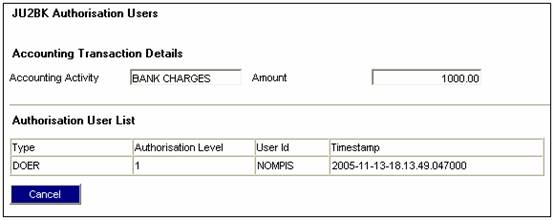
To generate a Payment Advice for administration fee payments, highlight a journal on the JU2BK Manual Accounting Journal screen and select Payment Advice from the sub-menu on the left.

Setup
Refer to the Translation Header setup section below.
The necessary Template Elements must be set up with the required Document Tags from the list and with a PDF Process Type of PAYMENT ADVICE and link them to a Document Template with a PDF Process Type of PAYMENT ADVICE. For details, refer to
Supplements
Tags
Payment Advice
Note:
In addition, the parameters for the Tax Invoice must have been set up first before the Payment Advice can be generated. Refer to Tax Invoice below.
The system will read the Document Template with a Process Type of PAYMENT ADVICE linked to the Product and create the PDF document as per the Document Template.
Payment Advice example:
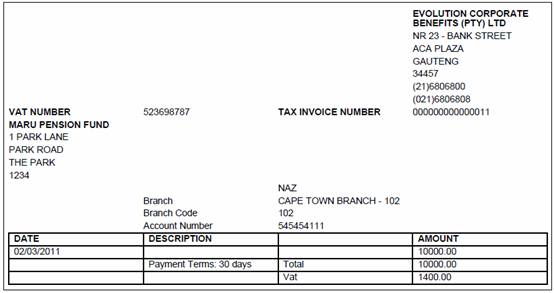
To generate a Tax Invoice for administration fee payments highlight a journal on the JU2BK Manual Accounting Journal screen and select Tax Invoice from the sub-menu on the left.

Setup
A Territory Parameter with a Parameter Type of TAX INVOICE NO and a value of Description of the Tax Invoice Number must be set up.
Refer to the Translation Header setup section below.
The necessary Template Elements must be set up with the required Document Tags with a PDF Process Type of PAYMENT ADVICE and linked to a Document Template with a PDF Process Type of TAX INVOICE. For more details, refer to
Supplements
Tags
Tax Invoice
The system will read the Document Template with a Process Type of TAX INVOICE linked to the Product and create the PDF document as per the Document Template.
Tax Invoice example:
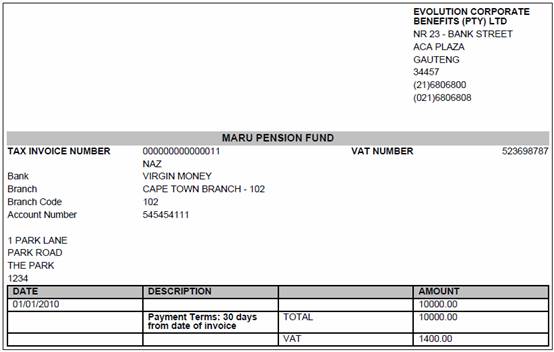
Processing
The system will read the Invoice Number on the Pre-Authorised Business Transact record and if it is null read the value for Description on the Territory Parameter with a Parameter Type of TAX INVOICE NUMBER and increment it by 1 and update the value for Invoice Number on the Pre-Authorised BT record.
Note:
The first time the Tax Invoice is extracted the invoice number will be stored on the Pre- Authorised BT record and thereafter each time it is extracted it will be extracted with the same number and the Territory Parameter will not be incremented. This means that if the Manual Accounting Journal is cancelled, the Tax Invoice will effectively be cancelled and that Tax Invoice number will not be re-used.
A Translation Header record must be set up with a Translation Purpose of PAYMENT ADVICE and with the following combination of Source System ID and Attribute and Target System ID and Attribute:
|
Source System ID |
Source System Attribute |
Target System ID |
Target System Attribute |
|
ACC JOURNAL |
ACCACTIVITY/QUAL |
PMT ADVICE |
PMT DETAILS |
For the combination of Accounting Activity and the Account Qualifier a translation value must be set up for the text that must appear on the Tax Invoice or Payment Advice for the Description of the payment as per the examples in the table below:
|
Source System Attribute |
Target System Attribute |
|
FEESPAID/ADM |
ADMIN FEES |
|
FEESPAID/INV |
INVESTMENT ADMIN FEES |
|
PREMIUMPAID/GLA |
GROUP LIFE PREMIUMS |
|
PREMALLOC/GLA |
GROUP LIFE PREMIUMS |
|
GENRLEXPENSE/TRU |
TRUSTEE EXPENSES |
Example:
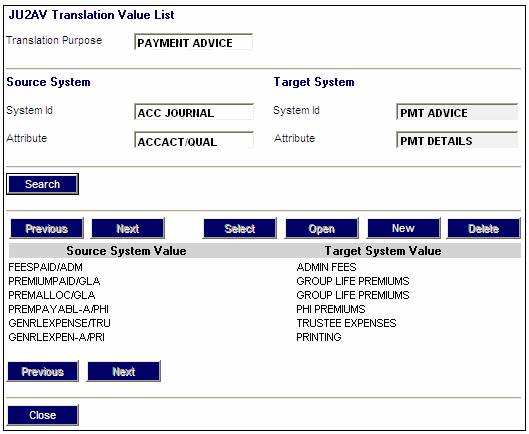
For a list of Document Tags for linking to the Document Template, refer to
Supplements
Tags
Payment Advice
This facility allows you to view any documents that have been uploaded for an accounting journal for a specific member of a product.
From the JU2BK Manual Accounting Journal screen, highlight the required accounting journal, then select View Document from the sub-menu on the left.

The Documents Uploaded screen will be displayed.

Click ![]() alongside Document Categories, then select the required document category to be viewed (e.g. Accounting etc.) from the drop-down list. The Document Categories field value selected will determine which Document Types are displayed for selection.
alongside Document Categories, then select the required document category to be viewed (e.g. Accounting etc.) from the drop-down list. The Document Categories field value selected will determine which Document Types are displayed for selection.
Click ![]() alongside Document Type to select from a drop-down list of document types. The Document Type field values displayed for selection are determined by the Document Category selected in the Document Categories field.
alongside Document Type to select from a drop-down list of document types. The Document Type field values displayed for selection are determined by the Document Category selected in the Document Categories field.
Note:
The system will only display the document categories and document types relevant to the particular menu and to which the user has access.
Any documents available for the type of document selected will be displayed.

Click on the hyperlinked document name in the Document Name column to view the document.
Note:
If the accounting journal selected is not linked to a membership, the following error message will be displayed:
Documents can not be viewed, as this transaction is not linked to a Membership.
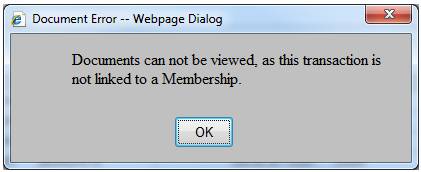
Click OK to remove the message.
This facility allows you to upload documents for an accounting journal for a specific member of a product.
From the JU2BK Manual Accounting Journal screen, highlight the required accounting journal, then select Load Document from the sub-menu on the left.

The Document Upload screen will be displayed.

Click ![]() alongside Document Type to select from a drop-down list of document types.
alongside Document Type to select from a drop-down list of document types.
Add any descriptive text in the Comment field.
Click BROWSE to find and select the document to be uploaded.
Click SUBMIT.
A message will confirm that the file has been successfully uploaded.
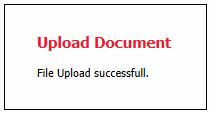
Note:
If the accounting journal selected is not linked to a membership, the following error message will be displayed:
Documents can not be loaded, as this transaction is not linked to a Membership.

Click OK to remove the message.